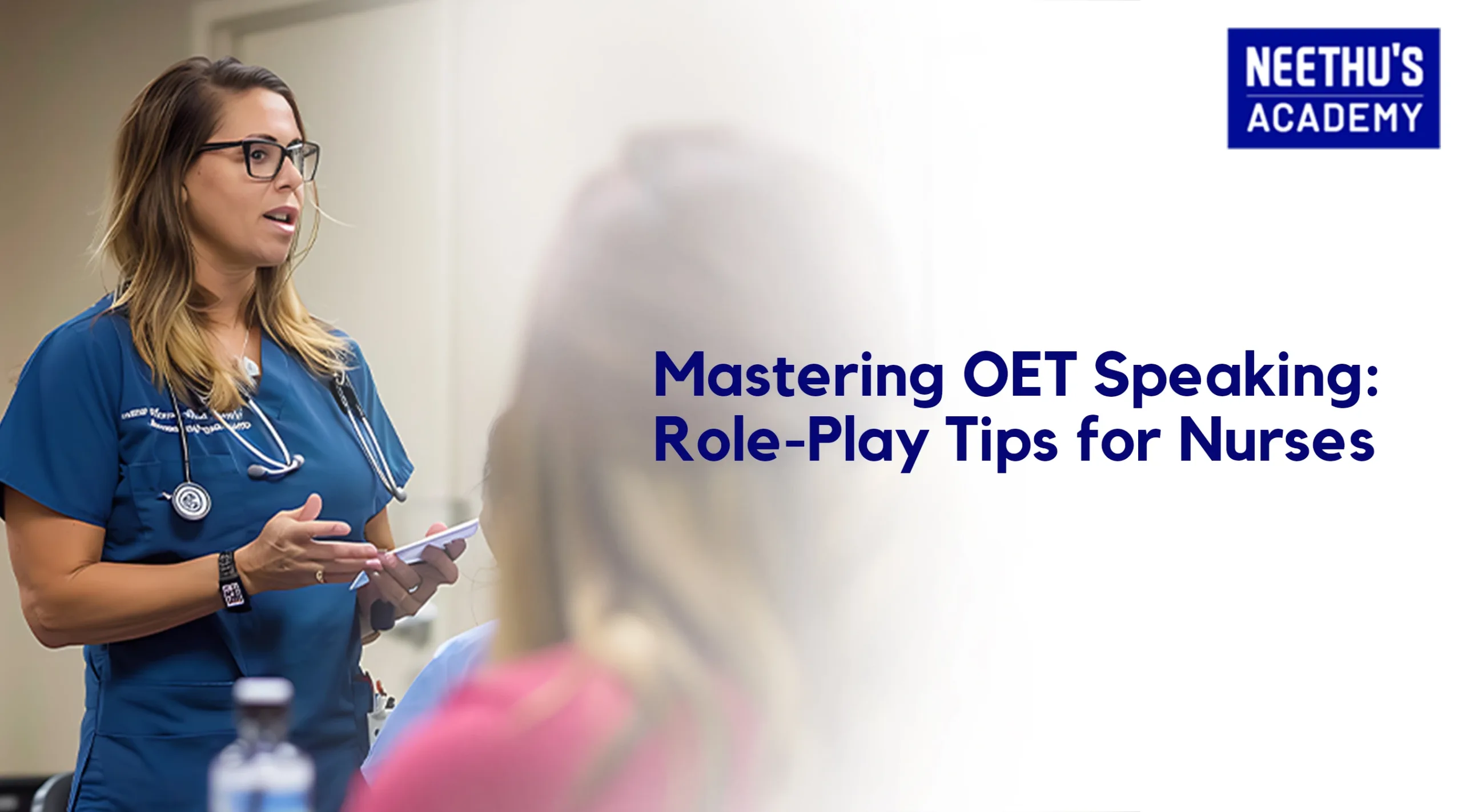OET Listening:A complete Guide
For all nursing professionals who wish to serve in an English-speaking country, the OET test is a game changer. Unlike any other general English proficiency tests, the OET has a special position for relevance to and value of, professionals in the healthcare sector. Out of the sub-tests in the OET Test, the Listening Test in the OET is particularly tough because it does not require language proficiency alone but also demands a medical context.
This blog has equipped you with step-by-step and deep-worded OET listening strategies and techniques to help you get your dream score!
What is OET Listening?
The Occupational English Test (OET) Listening section is determined to evaluate the test taker’s language proficiency in an English-speaking environment with an OET Listening sample, which actually is a real-time depiction of authentic/real scenarios in any healthcare setting. Listening subtests assess the candidates’ ability to comprehend spoken English effectively with OET Listening material.
What is the Structure of OET Listening?
For the effective preparation of the test, one should have a deep understanding of the test format. The OET Listening Test measures your ability to process spoken English in a healthcare environment. It lasts 45 minutes and is divided into three test parts.
Part A: Consultation Extracts
Part A comprises independent recorded health professional-patient consultations. This part tests the candidate’s listening ability to discern specific information and details, including patient symptoms, medical history, and treatment plans. You will be required to complete notes from what is heard in the two consultations. This may include filling the gaps, completing the sentences, or noting specific details relating to what is heard in the consultation.
Part B: Short Workplace Extracts
The audio recordings in Part B are very short, coming from different healthcare contexts, such as a briefing among staff or a handover. In fact, it might even represent a consultation with a health professional. You have to listen for the key idea or some specific details about the purpose of the audio you heard.
Part C: Presentation Extracts
In Part C you will listen to a couple of longer recordings that are based on health or healthcare-related presentations or interviews. This section still utilizes multiple-choice questions, but they are more elaborate and call for a greater degree of understanding of the content, which may include the speaker’s attitudes, opinions, or the gist of the whole conversation.
OET Listening Tips to Score Higher
Preparation is the key to succeeding in the OET Listening Test. Take a look at some targeted strategies to help you become better prepared.
Analysis and Practice: Practice going through official OET sample tests periodically. The more you through the test types and format, the less the level of your anxiety will be.
Get used to the context: Given the fact that OET is specific to health, it is good to familiarize yourself with the appropriate content. For instance, you could listen to medical podcasts, and documentaries, or be able to discuss healthcare themes in English.
Pick out keywords: Take heed of the kind of keywords that seem to be repeated both in the questions and in the recordings. This helps you listen to only that part of the recording relevant to the question.
Expose Yourself to Varied Material: Generalize the sources that you listen to. This could come from medical podcasts, radio programs, news, and patient-doctor interactions. This exposes you to varied accents, speed of speech, and terminologies in the field of medicine.
Engage in Active Listening: Employ active listening; rephrase what you hear. After you listen to a podcast or watch a video, for instance, repeat what points seemed most important. This kind of activity reinforces comprehension and retention.
Build up your Medical Vocabulary: As OET is designed for health professionals, strong knowledge of medical vocabulary is quite necessary. Make some flashcards or use some apps to learn new terms with their pronunciation daily.
Practice Strategies for OET Listening
The right kind of practice is the blend of regular drills and strategic preparation.
Mock Tests and Simulated Exams: One of the best methods of preparation is to simulate the test environment.
Realistic test environment: Take a practice test in a room where there will be no disturbances. Sit for the same period, and if the test calls for recordings, use headphones.
Performance Analysis: Review your answers following each and every mock test. Understand the reason for your mistakes and formulate strategies so that you can avoid them in the future.
Identify Weaknesses: From the test practice reports, find your weaknesses. If you are always poor at Part C, then concentrate more on the long-form listening exercises.
Time Management Tips
This would help you manage your time effectively in the test, and that counts a lot on performance.
Preview Questions: Run through the questions quickly before the recording starts. Be on the lookout for information and, thus, important details will not be omitted.
Prioritizing Accuracy Over Speed: While time management is critical, accuracy should not be compromised. This implies that one is supposed to ensure questions are answered correctly rather than on a speed basis in answering them.
Review your work: Reserve some time at the end of every part, if you can, to review your work. It’s a good moment that can help you catch any errors or details you may have overlooked.
Common Mistakes to Avoid in OET Listening Test
Errors do happen, but it’s a big No when it comes to your OET Listening Test. Knowing these common problems can help you to score better at the OET Listening Test.So let’s look at some of the common mistakes every test taker makes while attempting the OET Listening sample.
Unfamiliar Accents:One commonly faced challenge in the OET Listening Test is how to get spanned with different English accents. Getting Used to Different Accents in English: Make it a part of your regular listening habit to listen to speakers from the UK, Australia, New Zealand, Canada, and other countries to get yourself accustomed to the different pronunciations, speech patterns, and slang.
Minimizing Distractions:During the test, there will be several types of distractions ranging from background noise during the recordings to individual anxiety. Engaging yourself in listening practices, in which you will focus on what you can hear in a noisy background environment, will help a lot. It can be a noisy café or even a room with the TV blaring in the background. It trains your mind to focus on any subject at hand despite possible distractions.
Anxiety Management:Test anxiety is very common and can quite essentially affect your listening. The more the preparation, the more confidence you will have. Format of the test, practice, and good mastery of medical English can go a long way in reducing anxiety.
Fast Speed Dialogues:Sometimes it can be really challenging to catch up with conversations that occur at a fast speed, especially in professional situations. Gradually increase the speed level of the audio used for practice. Start with normal pace records and gradually go up to faster ones. This will train the ear to catch on to details even when the speaker is speaking fast. Also, Master the art of listening for key information, the likes of names, dates, or specific medical terms while endeavoring to answer the question accordingly, even if the dialogue is at a high speed.
Ignoring Instructions: Carefully read and follow instructions to avoid any kind of oversights occurring.
Passively Paying Attention: Stay attentive throughout passages to capture crucial details, a minute distraction can make you lose your marks.
Misreading the Context: Look for broader context so as to answer questions accurately rather than limiting your interpretation within a narrow context.
Skipping Vital Information: Make yourself capable of identifying and retaining crucial details rather than submerging yourself in unwanted or irrelevant details. Ensure accuracy to avoid providing irrelevant or incorrect answers.
Rightly acknowledging the above-mentioned mistakes and thereby rectifying them would help you gain a better score on the OET Listening Test.
Most Commonly Used OET Listening Practice Questions
Let’s have a brief look at the most commonly used OET Listening Practice Questions with examples that will help you understand what an OET Listening sample or material looks like when it comes to the real examination.
Part A: Consultation Extracts
This section is a consultation between a patient and a doctor. The doctor responds to the patient’s complaint about a persistent cough. Pay attention to the recording of the doctor’s response and consider what information they are seeking.
Question 1:
Patient: “I’ve been having this cough for two weeks now, doctor.”
Doctor: “Any other symptoms accompanying the cough?”
What is the doctor’s response most likely aimed at?
- A) Asking about the patient’s general health.
- B) Inquiring about additional symptoms related to the cough.
- C) Advising on treatment options.
- D) Requesting medical history.
Answer: B
Explanation:
In this example, the doctor’s response is quite focused on understanding whether there are any additional symptoms present alongside the cough. This helps the doctor assess the situation comprehensively.
The doctor’s inquiry about additional symptoms illustrates the importance of gathering comprehensive information during patient consultations to provide effective medical care.
Part B: Short Workplace Extracts
In this section, you will listen to a short conversation between a nurse and a patient. The patient mentions experiencing chest pain, and the nurse responds accordingly. Listen carefully to the nurse’s response and consider how they handle the patient’s concern.
Question 2:
Nurse: “Good morning, Mrs. Smith. How are you feeling today?”
Patient: “Hello, Nurse. I’m feeling okay, but I’ve been having some chest pain.”
Nurse: “I see. Can you tell me more about the chest pain? How long have you been experiencing it, and does it radiate to any other areas?”
Explanation:
In this scenario, the nurse responds to the patient’s mention of chest pain by asking follow-up questions to gather more or any specific information. This is important for understanding the nature and severity of the symptoms.
The nurse’s prompt follow-up questions demonstrate effective communication and the importance of gathering detailed information to assess patient symptoms accurately.
Part C: Presentation or Interview
In Part C, you will listen to a presentation about diabetes management. The speaker discusses key lifestyle changes recommended for diabetic patients. Pay attention to the main points emphasized by the speaker.
Question 3:
Speaker: “Today, we’ll discuss lifestyle management for diabetic patients. One key aspect is maintaining a balanced diet, ensuring you’re consuming a variety of fruits, vegetables, and whole grains.
Exercise is also crucial, with recommendations for at least 30 minutes of moderate-intensity activity most days of the week.
Lastly, it’s essential to maintain a healthy weight, as excess weight can exacerbate diabetes symptoms and complications.”
Explanation:
In this presentation excerpt, the speaker highlights three key lifestyle changes recommended for diabetic patients: a balanced diet, regular exercise, and weight management which are fundamental for effective diabetes management.
The speaker’s emphasis on these lifestyle changes underscores their significance in managing diabetes effectively and improving overall health outcomes for patients.
What are the scoring criteria for the OET listening test?
As mentioned the task types consist of multiple-choice questions and complete the sentence. For each correct answer, a specific weightage is contributed to the total score ranging from 0 to 500, mapped to grades A to E.
Language Accuracy: Language accuracy denotes the precision of using the right spelling and grammar for the responses.
Accent Variation: Make yourself familiar with diverse accents as it prepares professionals for real-world communication diversity encountered in healthcare settings.
Spelling Mistakes: Accurate spelling and grammar are a must-have to enhance response credibility, positively influencing scores.
Relevant Answers/Responses: Make sure you provide only the relevant details required. Any irrelevant detailing can make you lose marks.
Preview the Questions: With effective previewing of the questions learn to eliminate obvious incorrect options.
Active Listening: Listen attentively to predict the missing words, do not stick to the strategy of selective listening as it can confuse you with the OET Listening sample.
Look for Contextual Clues: Stay aware of grammar and sentence structuring as it can provide you with enough additional/specific details about the background.
To sum things up,
Getting the skills to crack the OET Listening Test entails preparation, understanding its format, developing one’s listening skills, and adoption of effective practice strategies. Combine the strategies and tips on the OET listening test to aid with confidence. Persistent practice assisted by a strategic plan, will make you successful in the OET. If you work hard enough for the score you want, you’ll definitely achieve it!
Frequently Asked Questions





